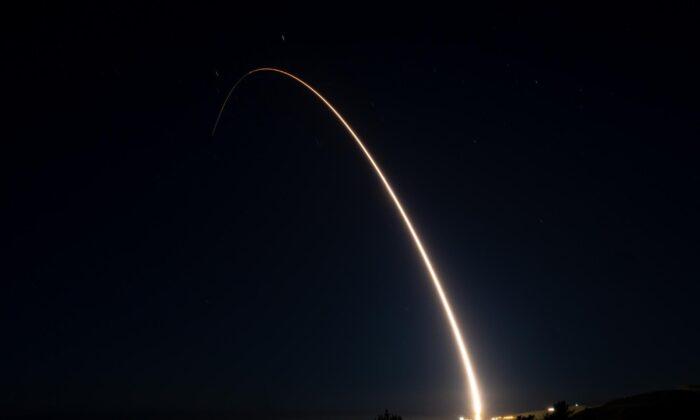The United States carried out a test launch of an unarmed Minuteman III intercontinental ballistic missile (ICBM) in California, said the U.S. Air Force in a statement on Tuesday.
The ICBM’s reentry vehicle went about 4,200 miles to a test site in the Pacific Ocean, according to the Air Force.
“Our Strikers and our nuclear mission are the bedrock of our nation’s defense and international security,” Gen. Thomas A. Bussiere, with the Air Force Global Strike Command (AFGSC), said in a news release.
“As part of that mission, our ICBM force provides 24/7 strategic deterrence and stand ready to respond at a moment’s notice as the most responsive leg of the nuclear triad, and our test launches demonstrate and confirm our readiness to deliver a safe, secure, effective, and credible, global combat capability.”
The launch was characterized as “routine” and part of “periodic activities” intended to showcase the United States’s nuclear deterrent efforts. Similar tests have been carried out 300 times in the past, the Air Force media release noted.
“This test is not the result of current world events,” it said.
Minutemen III ICBMs are capable of delivering a warhead and can travel at least 6,000 miles, reaching speeds of about 15,000 miles per hour. Those missiles are a key part of the U.S. nuclear deterrent triad.
“Today’s test launch is just one example of how our nation’s ICBMs, and the professional Airmen who maintain and operate them, demonstrate the readiness and reliability of the weapon system. It showcases our commitment to deterrence as we stand on continuous alert, 24/7/365,” said Col. Chris Cruise, 377th Test and Evaluation Group commander, in the release.
“An anomaly is any unexpected event during the test. Since anomalies may arise from many factors relating to the operational platform itself, or the test equipment, careful analysis is needed to identify the cause,” the statement said.
At the time, the AFGSC said the launch had terminated “due to an anomaly” without further explanation. However, the defense publication The War Zone described the failure as “concerning,” and one observer posted an image of what looked like “an unusual upswing in the trajectory of the missile” following launch.
It comes in the midst of elevated tensions after Russia invaded Ukraine in early 2022, which has been accompanied by a number of nuclear-related threats. Last month, Russian President Vladimir Putin announced drills near the Ukraine border that involved tactical nuclear weapons.
According to a statement by the defense ministry released about two weeks ago, the first stage of the new drills envisioned “practical training in the preparation and use of non-strategic nuclear weapons,” including nuclear-capable Kinzhal and Iskander missiles.
The maneuvers took place in the Southern Military District, which consists of Russian regions in the south, including on the border with Ukraine; Crimea, annexed from Ukraine in 2014; and four Ukrainian regions that Russia took over in 2022 and now partially occupies.
The drills were announced on May 6, with the defense ministry saying in a statement that they would come in response to “provocative statements and threats of certain Western officials regarding the Russian Federation.”
Tactical nuclear weapons include air bombs, warheads for short-range missiles, and artillery munitions and are meant for use on a battlefield. They are less powerful than the strategic weapons—massive warheads that arm intercontinental ballistic missiles and are intended to obliterate entire cities.







